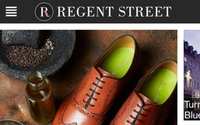Commentary
Beaconed Shoppers Return to Regent Street
- by Chuck Martin , Staff Writer, September 24, 2014
 The beacons are beginning to shine.
The beacons are beginning to shine.
After months of trials and experiments, more results of beaconing are surfacing and marketers and brands are learning what works.
Back in June, beacons were introduced to the 135 upscale stores, restaurants and bars on the famed Regent Street in London, which I wrote about here at the time (The Great iBeacon Rollout: 100 Stores on One Street).
Regent Street is owned by The Crown Estate, the property company of the queen, and run by The Regent Street Association.
The Regent Street app aggregates all the shops on the street. As a result, shoppers have to download only that app rather than a different one for each store, clearing one of the major beaconing hurdles.
When a person downloads the app, they see a personalized interest graph where they swipe things they like and dislike, creating an interest profile, which is then used for the Regent Street beaconing.
Most (80%) of the Regent Street stores now have working beacons providing targeted offers to passing shoppers, according to Henry Lawson, CEO of Autograph, the company that deployed and runs the Regent Street beaconing program for the association.
I caught up with Lawson yesterday for some early results in the Regent Street beaconing.
Counter to some perceived images of shoppers being constantly bombarded with beacon-triggered messaging, the Regent Street beaconing is measured, as are most of the leading beacon implementations.
“Typically, it’s one message per store, though some have up to five,” said Lawson. “They could be pinged about 10 times if walking the entire street on both sides, about a mile and a half.”
He noted that the same message from the same store is not repeated within three days. He also said the most common consumer reaction is why they cannot receive more than one message.
The other aspect is that the messages all are based on the interest profile the consumer creates when downloading the app. Lawson says almost all (99%) create a profile.
After downloading the Regent Street app, shoppers return to Regent Street 2 times on average per month, and almost half (48%) return to the street more than twice a month, Lawson said.
A key metric everyone is looking for is the level of engagement after a mobile shopper receives a beacon-triggered message.
Lawson said Regent Street is seeing a 6% click through rate on beacon-triggered messages.
One recent study of 100,000 mobile shoppers found that in-store beacon engagements cause a 45% interaction or engagement rate.
That study, by InMarket, also found a precipitous drop in app usage when a shopper is beaconed more than once, which I wrote about here earlier this week (Beaconed Once: 45% Engagement; Beaconed Twice: 313% Drop in App Usage).
I’ve heard of even higher engagement rates from beaconing outside of retail, which I’ll be writing about here soon.
In the case of Regent Street, the responses may be lower since the consumer is not yet in a store.
However, Lawson pointed out that the beacon responses are significantly higher, as in up to 100 times, than typical daily deals and branded retail offers.
In addition to requiring only one app for the entire street, there are other advantages of Regent Street beacons.
For example, the National Football League series of international games kicks off this weekend on, you guessed it, Regent Street, where 600,000 fans are expected to attend.
In early November, just two days before the MediaPost IoT: Beacons conference in New York, the Regent Street Motor Show, the largest free motor show in the U.S., will be held.
Regent Street beaconing will be heavily promoted at both events.
Serious beaconing has begun.
______________________________________________
Want to know more about beacons? Sign up for the MediaPost conference on beacons, for Nov. 3 in New York (IoT: Beacons), which I’m currently programming.



